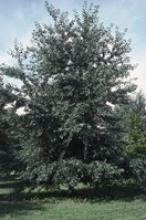
Altered wood composition (less lignin and more cellulose) resulting from the downregulation of the Caffeoyl Shikimate Esterase (CSE) enzyme through RNAi.
Grey poplar (P. x canescens) is dioecious (every tree is either male or female). The 717-1B4 clone is female. There is therefore no risk of dissemination through pollen. Moreover, as flower development occurs before vegetative bud burst and leaf development, it is very easy to identify and eliminate female catkins, before their full development. But as the modified poplars will be grown as short rotation intensive culture with a harvest of all trunks and branches after 3 years of growing, the GM poplars are not expected to flower. Suckers are also regularly monitored and destroyed by either removing them or killing them with a contact herbicide. After a storm the site will be inspected for possible fallen branches and these will be removed. The site is designed in such a manner that fallen branches will not disperse by wind from the plot and will remain within the boundaries of a fence surrounding the trial.
At the end of the trial, the rootstock will be mechanically removed and the soil will be worked with a rotary cultivator. The plot will be monitored for at least two years for suckers, which will be destroyed using a suitable contact herbicide. If necessary monitoring will be extended until there has been one year without any suckers.
The field trial plot will be surrounded by a 1.80 m high wire fence to prevent accidental trespassing and accidental removal or spread of GM material.
Authorized.
Information for the public
-
-
-
-
Public information presented according to the provisions of Directive 2001/18/EC
Information related to the decision procedure
-
10 May 2021: The Biosafety Advisory Council issues a positive advice (with conditions) for this trial.
-
2 June 2021: The Federal Ministers give a positive decision (with conditions) for this trial.
